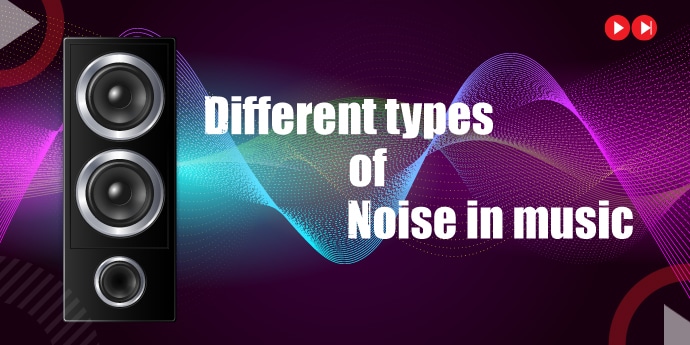Noise occurs in a variety of forms, sizes, and tones. Understanding the differences between the different forms of noise is essential to effectively measuring and analyzing it. It becomes much simpler to choose the appropriate equipment and characteristics to employ after that.

Whether it’s the simple beep that punctuates our lives, a plane flying overhead, or the heavy machinery in your workplace, we can’t avoid noise. If you want to measure and analyze it accurately, you need to understand the difference between the types of noise.
We will see what noise is and various kinds of noise types for analyzing it!
What is Noise: Basic Definition
To grasp the difference between noise and sound, one must first understand the term “noise.” Noise is a sound that may be described as undesirable, irritating, unpleasant, or loud. Noise sounds are most typically characterized by an annoying tone that causes moderate to severe pain or irritation. Our ears are pretty good at distinguishing between different types of noise.
These tones pierce the background noise that accompanies our lives. When measuring different types of noise, we want to reiterate how the human ear interprets noise to provide an accurate representation of its effect. That is why we use something called an A-weighted frequency, which is very sensitive between the 500 Hz and 6 kHz range.
Different Types of Noise
Continuous Noise
Continuous noise is produced by devices or equipment that continue to operate indefinitely. In a manufacturing environment, this form of noise is produced by massive equipment that runs continually to ensure that output is steady throughout. These sounds are audible and occur all around us, no matter where we are in the world.
Intermittent Noise
Intermittent sounds are noises that occur infrequently yet often throughout the day. In most cases, they are caused by loud bursts of energy that you detect but are not astonished by. These sorts of noise might have a significant influence on your overall quality of life at times. For many individuals, living in an area where they can hear jets take off at all hours of the day and night is not an option.
Impulsive Noise
However, impulsive noise does not occur regularly and is overlooked by the listener. People are more likely to notice anything unusual if it comes from a sudden burst of sound or a loud bang. These sorts of noises are often heard in restaurants due to waiters or waitresses accidentally dropping a pile of plates on the floor.
When this occurs, the atmosphere in the restaurant often becomes a bit more relaxed as people search for the source of the noise. The yelling of strangers on the street or concrete blasting from construction sites are also called impulsive sounds.
Low-Frequency Noise
Low-frequency noise is generated by the items that surround us in our daily lives. It is one of the most challenging forms of noise to eliminate. It may cause a supposedly quiet environment to detect roughly 30-40 dB sound levels while being completely silent. This noise is often heard in an office environment, coming from a heating or ventilation system.
A grandfather clock ticking away in your living room provides the source of the sound. Most of the time, we are not even aware that we are hearing this form of noise until we pay close attention to it.
We hope different types of noise and the basic definition of noise were clear to you. Now you can analyze the noises that surround you.
Now let’s see how you can get rid of white noise when recording and get rid of white noise in the Mic.
What Is White Noise?
All sound waves can be divided into two categories: frequency, or how fast the wave is shaking per second, and amplitude.
White noise is defined as noise that contains a variety of all sound frequencies that the human ear can hear (about 20 Hz to 20 kHz). This type of noise includes low-, mid-range- and high-frequency sounds.
How to Remove White Noise from Audio?
5 Ways to Reduce Noise While Recording Dialog
- Decrease subject-to-microphone distance, increase microphone-to-noise distance.
- Eliminate background noise sources.
- Use a directional microphone.
- Use a microphone or low-cut filter in the first step of amplification.
- Reduce the number of open microphones.
How to get rid of White Noise in the Mic?
Fit a shock mount to the mic stand to reduce background noise caused by shock and vibration. Use a windshield – it fits over the head of the Mic and reduces unwanted wind interference – as well as heavy breath! There are also types of microphones that helps to reduce background noise and unwanted sounds.
Like white noise, we also want to get rid of loud annoying noises. Let’s see a list of loud annoying noises.
List of 10 most Loud Annoying Noise
Noise comes in various forms and is a general term that we don’t use to describe anything on our recordings. It may just be some background environmental noise that adds context to a location recording but is very impressive and distracts from the subject. Alternatively, it could be electronic interference that is affecting our audio intermittently and unpredictably. This is any background audio that is surplus to requirements. You can also avoid unwanted sounds by wearing noise-canceling headphones.
These are some of the most common annoying sounds:
- Wind
- Electrical Noise
- Interference
- Ground Loops
- Rumble
- Mechanical Noises
- Equipment Self Noise
- Background Noise
- Plosives
- Sibilance
Conclusion
So, these are the variety of noise in music. We are sure that now you’re clear about the different noises between various noises in music. If there is anything left related to noise from our side, you can tell by writing in the comment section below.









